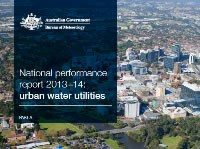National Water Performance Report shows shift to diverse water sources
07/05/2015

A report comparing the performance of 78 nation-wide urban water utilities during 2013–14 has been released by the Bureau of Meteorology today, highlighting an increased reliance on diversified water sources in Australia’s highly variable climate.
The National performance report 2013–14: urban water utilities is the ninth in a series of national urban water performance reports.
Dr Ian Prosser, Assistant Director Water Information Services at the Bureau, says while surface water remains the dominant source of water supplied across the country, Western Australia and South Australia have seen a decrease in reliance on historically dominant supply sources – such as groundwater and surface water.
“Below-average rainfall has had an impact on many major east coast and inland urban centres over the past year, with drier than average conditions also persisting in the west and southwest of Australia,” said Dr Prosser.
“This has seen a shift towards more climate resilient water sources, particularly in Western Australia and South Australia, where both states have reported increases in water sourced from desalination.”
Dr Prosser said slight increases in residential water consumption in 2013–14 – the third consecutive year of observed increases – could likely be attributed to hotter temperatures, average or below-average rainfall, and easing of water restrictions across Australia.
“Rainfall is arguably the most influential factor affecting residential consumption, and drier conditions were compounded by above-average temperatures in 2013 and 2014, which were the hottest and third hottest years respectively since official temperature records began in 1910.”
Nationally, the median volume of residential water supplied was 185 kilolitres (kL) per property, up three per cent from 179kL in 2012–13.
The overall increase in the median typical annual residential water bill was 2%; while the median combined operating expenditure per property remained steady, decreasing by less than 1% from $887 in 2012–13 to $880 in 2013–14.
Mr Adam Lovell, Executive Director Water Services Association of Australia (WSAA) welcomed the release of the National Performance Report and the continued transparency of the urban water industry.
“Australia is a world leader in robust and regular public reporting. It is great to see a reduction in the national median for water and sewerage complaints, which reflects the hard work of utilities to meet customers’ needs and improve their engagement. It is also pleasing to see that drinking water quality, already very high in most areas for many years, continues to improve in regional supplies,” said Mr Lovell.
National water performance reports are produced annually to benchmark the efficient performance of water utilities, independently and publicly. The National Water Commission produced previous performance reports
The 2013–14 urban performance report provides data from 78 reporting utilities, providing water services to over 20 million people. It has been prepared jointly by the Bureau of Meteorology, state and territory governments, and the Water Services Association of Australia.
The urban performance report contributes to the Bureau’s Improving Water Information Programme, which is building a comprehensive and reliable picture of Australia’s water resources to support policy and planning.
For more information: www.bom.gov.au/water/npr










